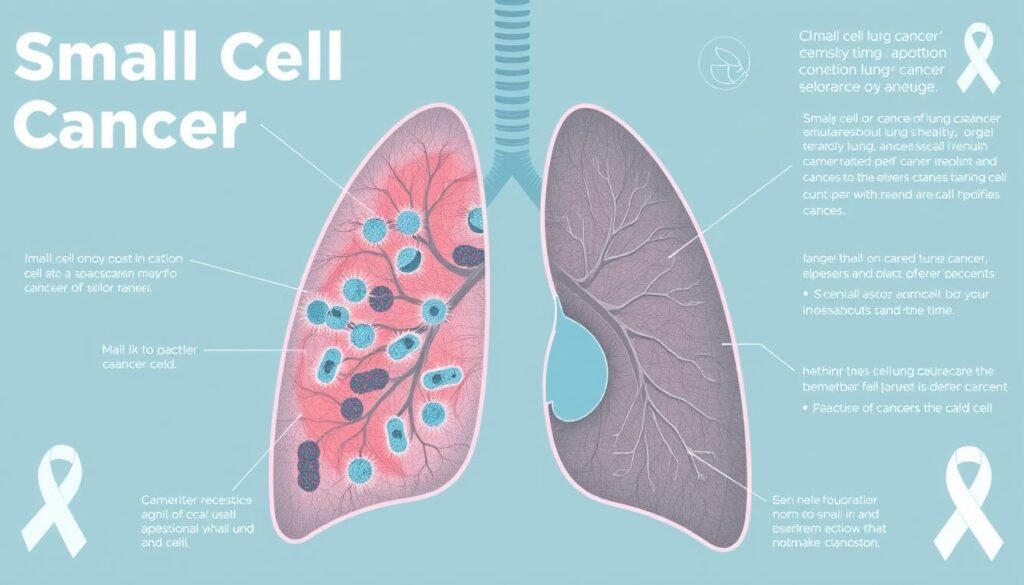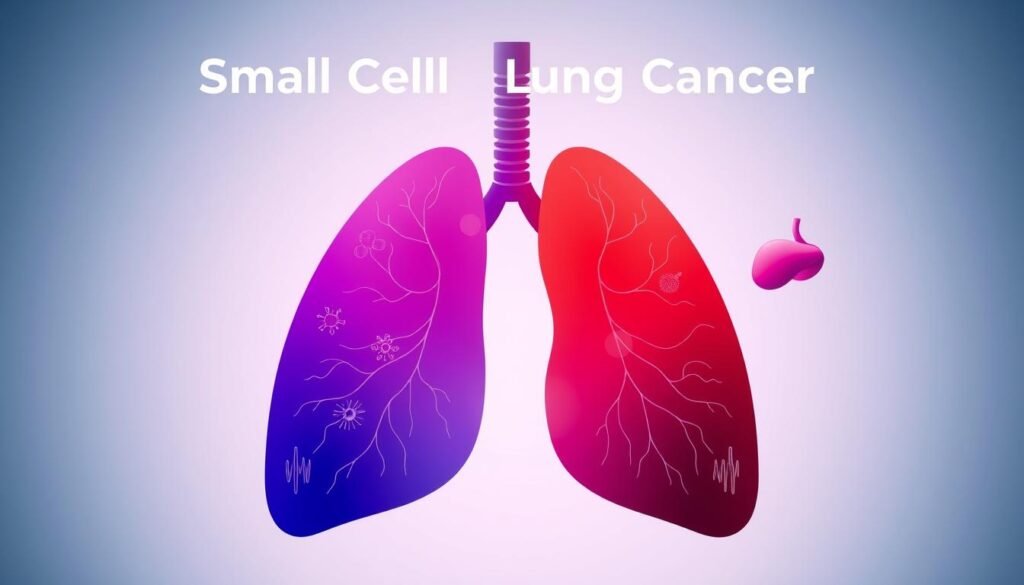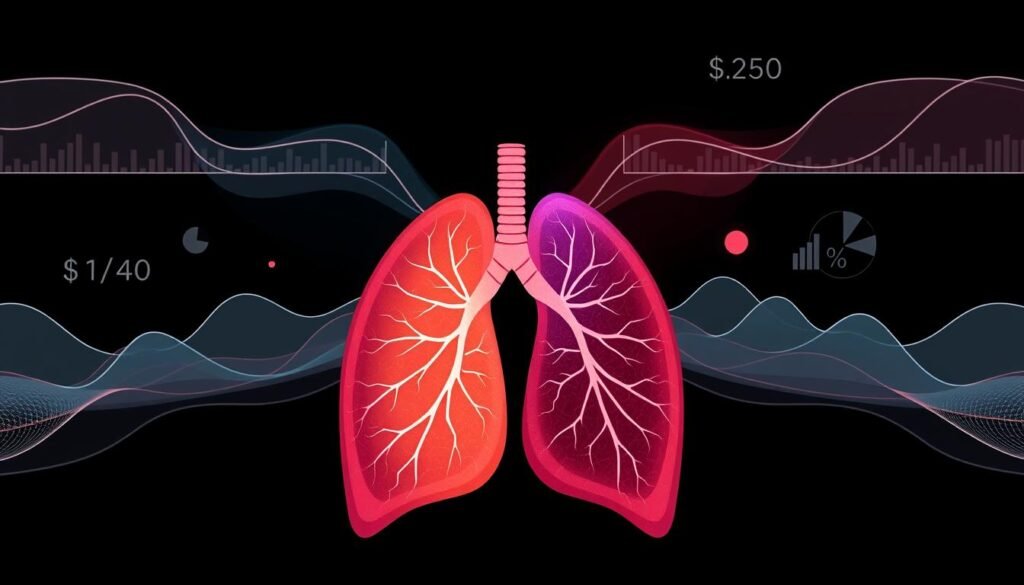Did you know small cell lung cancer (SCLC) makes up about 10–15% of all lung cancer cases? Yet, it’s known for its tough survival rates. Patients’ life expectancy differs greatly. This depends on when the cancer is found and how effective treatments are. Most people learn they have SCLC when it’s quite advanced.
The average 5-year survival rate for those with SCLC is just 7%. This fact points to the aggressive nature of this cancer, often linked to smoking. It shows why knowing about SCLC is so important. This knowledge helps patients and their families prepare for what’s coming.
About a third of people find out they have SCLC while it’s still contained. But, two-thirds get the news when the cancer has spread far. Even with new treatments making a difference, patients still face big health challenges. This makes it critical to understand what lung cancer life expectancy means.
Key Takeaways
- Small cell lung cancer represents 10–15% of lung cancer diagnoses.
- The average 5-year survival rate for SCLC is only about 7%.
- Local diagnosis leads to a 27% survival rate, while advanced stages diminish hopes significantly.
- Most patients with SCLC have a history of smoking, making prevention efforts crucial.
- Understanding SCLC survival statistics helps in navigating treatment and care options.
Understanding Small Cell Lung Cancer
Small cell lung cancer (SCLC) is a rare yet aggressive lung cancer type. It makes up about 10-15% of all lung cancer cases. The small cell lung cancer definition shows it as one of two main types, the other being non-small cell lung cancer. This type quickly worsens, often getting diagnosed at a late stage.
SCLC has two main stages: limited and extensive. In the limited stage, cancer stays in one lung and nearby lymph nodes. The extensive stage means the cancer has spread to both lungs or other body parts. Sadly, about 65% of new cases are already in the extensive stage. This highlights how crucial early detection is for better outcomes.
Smoking and exposure to harmful substances increase the risk of getting this cancer. Men have a higher risk than women, but the difference is shrinking. In the past, Caucasians were more likely to get it than African Americans.
The cancer is very aggressive. The average survival time for patients is around 7 months. But, treatment can sometimes extend life beyond 12 months, even for serious cases. Treatment improvements have slightly raised the 5-year survival rates from 4.9% to 6.4% over the years. Younger patients have seen the most benefit.
To sum it up, knowing about small cell lung cancer means understanding its fast growth, the difficulty in early diagnosis, and the treatment options. These treatments aim to extend patient’s lives and improve quality of life.
What is Small Cell Lung Cancer?
Small cell lung cancer (SCLC) grows quickly and is less common than other lung cancers. It makes up 10% to 15% of all lung cancer cases. Most people with SCLC, about 97%, used to smoke. This shows how smoking is a big cause of SCLC.
People are usually about 66 when they find out they have SCLC. They might have a cough that won’t go away, chest pain, or lose a lot of weight. These signs can be easy to miss, as they seem like smaller problems. That’s why knowing these signs is important for catching the cancer early.
SCLC can be in a limited stage or an extensive stage. People with limited-stage SCLC can get chemo and radiotherapy. This treatment helps some live more than two years after finding out they have cancer. But the outlook isn’t as good for those with extensive-stage SCLC. Without treatment, this stage can quickly lead to death.
For limited-stage SCLC, the median survival time is 17.3 months. For extensive-stage, it’s only 8.8 months. After the first treatments, some patients might get more chemo. For them, the median survival is 6.6 months. This shows how important it is to keep looking for better treatments for SCLC.

Understanding SCLC’s signs helps those affected get help sooner. This can lead to better chances of survival. Researchers are always searching for new treatments and ways to prevent lung cancer. They’re studying genetic changes and how to stop cancer before it starts.
For detailed stats and information, check out the American Cancer Society.
Small Cell Lung Cancer Stages
The staging of lung cancer is key in deciding treatment and predicting patient outcomes. Small cell lung cancer falls into two groups: limited stage and extensive stage. These stages show how serious the cancer is.
About 33% of patients have limited-stage cancer when diagnosed. Here, cancer hasn’t spread beyond one lung and maybe nearby lymph nodes. Treatment often involves a single radiation field. On the other hand, 67% have extensive stage cancer at diagnosis. This means the cancer has spread to other body parts, like the liver or bones.

Doctors use the TNM staging system for accurate classification. It checks tumor size, lymph node involvement, and spread to other organs. This system goes from stage 0 (early cancer) to stage IV (advanced cancer).
| Stage | % 5-Year Survival Rate | Characteristics |
|---|---|---|
| Stage 1 | 65% | Cancer confined to one lung with potentially local lymph node involvement. |
| Stage 2 | 40% | More extensive local and lymph node involvement in the same lung. |
| Stage 3 | 15% | Cancer spread to lymph nodes in the chest. |
| Stage 4 | 5% | Advanced cancer that has metastasized to other regions of the body. |
In summary, knowing the stages of small cell lung cancer is vital for its management. Understanding limited versus extensive stages helps guide treatment choices, aiming to improve patient outcomes. Early detection and management are critical in fighting this aggressive cancer type. For more on staging, visit this resource.
What is the life expectancy of someone with small cell lung cancer?
Finding out the life expectancy for someone with small cell lung cancer (SCLC) is tough. This is because SCLC grows quickly. On average, people with limited-stage SCLC live between 12 to 16 months. Those with extensive-stage SCLC usually have a life expectancy of 7 to 11 months.
Median Survival Rates Explained
It’s important for patients and their families to understand survival rates. For those with SCLC, there’s a big difference in survival based on the stage. About 33% are diagnosed at the limited stage and can receive strong treatments. Sadly, around 66% have extensive stage, which is harder to treat. Without treatment, life expectancy drops to 2 to 4 months.
Comparison with Non-Small Cell Lung Cancer
NSCLC patients usually have a better life expectancy than SCLC patients. Their survival ranges from 11 to 13 months on average. Subtypes of NSCLC, like adenocarcinoma, might live around 25.82 months. Large cell carcinoma patients have a life expectancy of 11 to 14.2 months, and those with squamous cell carcinoma live about 10.1 to 12.9 months. This shows NSCLC patients generally have better chances.
New treatments are helping SCLC patients live longer. Research and modern therapies are offering hope. This means life expectancy for SCLC might get better soon. For detailed stats and info, check this comprehensive resource.
Small Cell Lung Cancer Survival Rates
It’s important to know about small cell lung cancer survival rates. This type of cancer makes up 15-20% of lung cancers. It’s very aggressive. Sadly, only about 7% of patients live for five years after being diagnosed.
5-Year Survival Rate Statistics
The survival rates for this cancer depend on when it’s found. If it’s caught early, the 5-year survival rate is almost 27%. But, if it’s found when it’s already spread, the rate drops to 3%. Here’s a table showing survival rates based on the cancer stage:
| Stage of SCLC | Median Survival (Months) | 5-Year Survival Rate |
|---|---|---|
| Limited Stage | 16-24 | 14% |
| Extensive Stage | 6-12 | 3% |
Factors Influencing Survival Rates
Many factors influence survival rates. Some key factors are:
- Stage at diagnosis
- Performance status of the patient
- Weight loss before treatment
- Serum lactate dehydrogenase levels
- Absolute neutrophil count
Effective treatments like chemotherapy can improve survival rates. Even patients with advanced cancer might get more time from salvage chemotherapy.

Small Cell Lung Cancer Prognosis
The outlook for small cell lung cancer (SCLC) depends on various cancer prognosis factors. Knowing these factors can help paint a picture of what to expect. An important factor is the cancer’s stage when found. Limited-stage SCLC is less common, making up 20% of cases. It has a survival time of about 1.5 to 2 years. About 10-15% of these patients can be cured.
On the other hand, extensive-stage small cell lung cancer is more common. It happens in about 75-80% of cases. These patients often live 10 to 12 months after diagnosis. This shows why finding the cancer early is key to a better outcome.
Other key cancer prognosis factors include the symptoms seen at diagnosis. Symptoms like weight loss and breathing trouble can mean the cancer is far along. This makes the outlook worse. Also, how patients respond to treatment can differ, highlighting the need for custom treatment plans.
Combining immunotherapy with chemotherapy has improved survival rates for small cell lung cancer patients. Comorbidities, or other health issues, can affect how well treatments work. This is especially true for those with less advanced disease. Ongoing research aims to find ways to lift survival rates further.
Noticing early signs of lung cancer can lead to faster treatment. Signs include a lasting cough and losing weight without trying. For more details on spotting these signs, visiting warning signs to know can help.
Factors Affecting Small Cell Lung Cancer Life Expectancy
Several factors affect how long small cell lung cancer patients live. These factors help us understand what to expect regarding treatment and survival chances. The stage when the cancer is found and the patient’s health matters a lot. They greatly influence how well someone can handle treatment and their survival.
Stage at Diagnosis
Finding the cancer early is crucial for coming up with a treatment plan and predicting the outcome. If the cancer is found early, treatment can work better. For instance, patients found with early-stage cancer live about 24 months on average. This is much longer than those diagnosed at a late stage, who survive around 11 months. This shows why we must catch cancer early.
Patient’s Overall Health and Treatment Response
A patient’s health can make a big difference in fighting cancer. Those in good health often see better results from treatment. Also, stopping smoking can reduce the risk of dying by almost half. This shows how important lifestyle choices are. Using a mix of chemotherapy and radiotherapy also improves the chances of living longer, especially for early-stage cancer. How patients react to their first treatment and the strength of the treatments matter too.
For more information about recognizing early lung cancer signs, please visit early lung cancer symptoms.
| Factor | Impact on Life Expectancy |
|---|---|
| Stage at Diagnosis | Earlier stages correlate with better survival rates. |
| Overall Health | Healthier patients respond better to treatment. |
| Smoking Status | Quitting smoking significantly reduces mortality risk. |
| Treatment Type | Combination therapies enhance survival chances. |
| Response to Treatment | Strong initial response leads to improved outcomes. |
Small Cell Lung Cancer Treatment Options
When treating small cell lung cancer (SCLC), options depend on the cancer’s stage and the patient’s well-being. Treatment for limited-stage disease usually involves chemotherapy and radiation together. This method improves survival chances and may even cure some.
Patients with limited-stage SCLC can live 16 to 24 months on average with treatment. A few reach a 5-year survival rate of 14%.
For those with extensive-stage SCLC, treatment plans change. They get chemotherapy with immunotherapy drugs like atezolizumab or durvalumab. These drugs help the body fight the cancer better and have shown good results in extending lives and shrinking tumors.
Such patients typically live 6 to 12 months, but new treatments could offer more hope.
Radiation therapy helps reduce symptoms like breathing problems and bleeding in advanced SCLC. Prophylactic cranial radiation can also help prevent the cancer from coming back in the brain for some patients. SCLC treatment is advancing, and clinical trials for new drugs might provide additional treatment options.